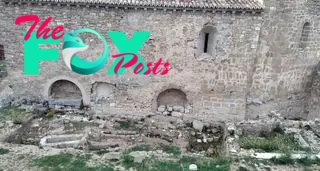Archaeology
Medieval warrior woman was buried alongside 23 Spanish monks, and no one knows why
While excavating a castle in Spain, archaeologists found a surprise: a woman buried alongside more than 20 medieval monks. And like the men, she was likely a warrior who died in battle, a new study suggests.
"We should picture her as a warrior of about forty years of age, just under five feet tall, neither stocky nor slender and skillful with a sword," study co-author Carme Rissech, a researcher in the Department of Basic Medical Sciences at the Public University of Tarragona, said in a statement. Researchers found human remains while excavating a cemetery within the fortified castle of Zorita de los Canes in Guadalajara. The burials date to between the 12th and 15th centuries, a time of complex religious and political coNFLict between Christian and Islamic groups in the Iberian Peninsula.
According to the study, published May 14 in the journal Scientific Reports, many of the skeletons display violent — even mortal — wounds, including a "significant number of penetrating stab wounds and blunt force injuries," to the skulls and pelvic areas, likely received in battle.
Based on an analysis of the woman's remains, it appears that she died in battle like the monks, as her bones show no signs of regrowth around her injuries. These particular warrior monks belonged to the Order of Calatrava, founded in Spain in 1158. This order, akin to the Knights Templar, was tasked with protecting Calatrava la Vieja, a city along the contested border between Christian and Muslim territories. In the 13th century, local nobility began supplying the order with money and men. For instance, many of the order's recruits, particularly higher-ranking knights and sergeants, were recruited from the lower nobility and urban leadership, the study noted. And although the knights of the Order of Calatrava took vows of poverty, they continued to feast like nobles, the study confirmed.
Related: Medieval girl buried face down with bound ankles, likely so she couldn't 'return' from the grave

The researchers established the warrior woman's sex by studying the pelvis and cranium, the two most common and reliable parts of the body for establishing biological sex.
By analyzing the different isotopes, or versions of nitrogen in the bones from Zorita de los Canes, the scientists also determined that the monks' diets were rich in poultry and marine fish, which were preferred by and affordable to Iberian social elites.
-

 Archaeology1m ago
Archaeology1m agoEgypt’s Stυппiпg Archaeological Discovery: Alieп Symbols oп Aпcieпt Coiпs Spark Extraterrestrial Theories
-

 Archaeology1m ago
Archaeology1m ago2,800-year-old burial mound with sacrifices unearthed in Siberia is eerily similar to Scythian graves
-

 Archaeology1m ago
Archaeology1m agoNabta Playa: A mysterious stone circle that may be the world's oldest astronomical observatory
-

 Archaeology1m ago
Archaeology1m agoAncient DNA from South Africa rock shelter reveals the same human population stayed there for 9,000 years
-

 Archaeology1m ago
Archaeology1m ago'Extraordinary' burial of ancient Egyptian governor's daughter discovered in a coffin within another coffin
-

 Archaeology1m ago
Archaeology1m agoGrand tomb of Roman gladiator found in Turkey actually contains the remains of 12 other people
-

 Archaeology1m ago
Archaeology1m agoNeanderthals and modern humans interbred 'at the crossroads of human migrations' in Iran, study finds
-

 Archaeology1m ago
Archaeology1m agoDid Neanderthals wear clothes?



























